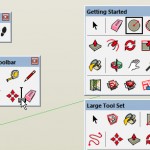We may receive a commission when you use our affiliate links. However, this does not impact our recommendations.
Two month ago as I walked down Madison Ave, I noticed a book proudly crowning a pyramid of "New York Times 'best sellers' " stack in the window of a respectable bookstore. The book that caught my eyes was The Lost Carving: A Journey into the Heart of Making, by David Esterly (Viking: New York, 2012).
The cover of the book as well as the pictures and plates appeared to sing the praises of craftsmanship, carving, wood, and the inner philosophy that motivates a maker of handmade objects. Immediately upon seeing this book, I thought that I have to let my readers know about it. My second thought was identifying the best person to write the review. That person is my friend and colleague Steff Rocknak. Steff is a master carver, a philosopher, and a great writer. Steff gladly agreed to my offer to to write this review. So without further adieu:
Review of The Lost Carving: A Journey into the Heart of Making, by David Esterly (Viking: New York, 2012)
In 1986, David Esterly won a competition to carve a replacement of a Grinling Gibbons “wall drop” for Hampten Court Palace, in East Molesey, England. His task was an onerous one: Gibbons invented a style of carving that has been matched by few, and surpassed by still fewer. Esterly is one of the latter few; his technique is superb.
The Lost Carving gives us an account of those fateful days at Hampton Court. Interwoven with memories of recreating the Gibbon’s piece, Esterly explains how he got involved with the esoteric field of limewood carving. Although he successfully completed his Ph.D. in English literature, he chose to avoid academia. Gibbons got to him instead, thanks to a chance encounter with one of his carvings in the 1970’s. Ever since, Esterly has struggled to understand, if not reach beyond, Gibbon’s vision and talent.
Indeed, if Esterly’s book was one of the carved wall drops at Hampton Court, this struggle would be one of the “flower ropes.” Not a delicate, exquisitely carved stem, hovering in the background, but a bold foreground element. This struggle dominates Esterly’s book, just as the flower rope dominates his Gibbons’ reproduction. While making the flower rope, Esterly tells us he foundered: Is it right? Does it bulge too much? Even if does, does this matter? Similarly, throughout The Lost Carving, we see Esterly constantly asking of his own work: Is this how Gibbons would have done it? Am I better than him? Does it matter? We are privy to a conversation between an artist and his muse—but this is a muse that never seems to leave Esterly alone. Gibbon’s influence on Esterly is relentless.
Critics of Gibbons tend to view him as a mere “craftsman,” a master of the decorative, a technical virtuoso, but hardly a master of the human condition. “Craft,” although technically competent, is often thought to be intellectually lacking. It this absence that prevents the work from adequately addressing the matters that “art” should be concerned with: death, politics, love, philosophy, etc. Moreover, representational visual art, i.e. work that represents things that we find in nature (such as flowers) is viewed by many as being rather vacuous—it is mindless “copying.” Thus, representational craft, e.g. a carved flower, is, in effect, twice condemned.
Consider a hand-made custom bicycle. Although the bike may be beautiful and exquisitely made, it is not, many would say, “art.” It has no intellectual or emotional depth, and so, is incapable of addressing what “art” should. But if we put it in a gallery or museum and hung an artist statement by it, many would be compelled to count it as art. The artist statement (and the venue) would, it seems, provide the requisite intellectual and emotional depth. Also, the fact that the bike no longer has an overt function—i.e. it is not being ridden—implies that it is more art than craft. Similarly, if we attach an artist statement to a representational piece and/or put it in a particular venue, e.g. a prestigious museum, all sins of “copying” seem to be forgiven.
Generally speaking then, we appear to live in a time where proper “art” should a.) Be intellectually/emotionally stimulating, b.) Not have an overt function (other than to be intellectually/emotionally stimulating) c.) Not be a mere copy. Objects that don’t satisfy a.) – c.), although handmade and technically competent, are, generally speaking, classified as “craft.”
It’s no surprise then, that Esterly addresses the status and classification of his work throughout the Lost Carving, sometimes obliquely, and sometimes directly.
His oblique response comes in the form of his frequent references to Yeats and other poets and philosophers. This literary/philosophical commentary effectively plays the role of an artist’s statement. Intentional or not, it provides the intellectual and emotional stimulation that some might claim is lacking in Esterly’s carvings. Thus, The Lost Carving makes an indirect case for Esterly’s work—and likewise, for Gibbon’s work—to be counted as proper art, as opposed to being say, clever decorations, i.e. “craft.”
As far as Esterly’s direct response to the art/craft distinction is concerned, he explains that he was instrumental in getting Gibbon’s work into a prestigious museum, which, as suggested above, can almost immediately change how the public views an object; an architectural decoration suddenly becomes art. But, we learn, this was no easy task.
We also see Esterly openly confront some of the giants of the contemporary art world, e.g. Jeff Koons, who has recently taken up wood carving. Or at least, Koons has been paying wood carvers to sculpt objects that he subsequently signs his name to. Koons, Esterly tells us, does not want to dirty his hands with the actual making of a piece, preferring to remain in the “pure” intellectual realm. Esterly writes: “The only craft should be in the craftiness of the conceit. Art is ideas, and ideas reside in the brain. The rest is execution. In fact, having someone else do it for you preserves your purity.” (The Lost Carving, 194)
I have always thought that many contemporary artists unwittingly embrace some kind of odd variant of Platonism, where ideas, i.e. the intellect as manifest in the written and spoken word is paramount, and the image, and likewise, the object, is secondary. So, when I saw Esterly suggest as much in the course of discussing Koons (and elsewhere), I felt a certain kinship. The art world is, I think, in a state of crisis. Many visual artists seem to think that they need to be philosophers, or, at the very least, some kind of intellectual and/or writer. In fact, as already suggested above, the objects artists make often seem to be less important that the artist statement, regardless if that statement is provided by the artist, or by a critic. However, many times we see that the artist statements and/or the critic’s explanations are vacuous or, worse still, are utterly incoherent.
But what if the artist’s statements and/or critics’ commentary are not abhorrent? For in some cases, e.g. in Esterly’s case, the commentary is thoughtful and elegant. Would visual art objects survive without them? Is intellectual/emotional content—particularly, verbally expressed (written or spoken) content—necessary in order for an object to count as “art?”
Although I enjoy Esterly’s discussion of poets and philosophers, I do not think it is necessary. His work needs no “artist statement,” implicit or not. Nor do fine furniture makers or custom bicycle makers need artist statements, critics’ endorsements or prestigious venues. Beautiful things, with little or no overt intellectual and/or emotional content have a place in the art world—regardless if they perform a function or not. Certain objects found in nature (e.g. a flower) may help me to make my case. Some of these objects are, many would admit, quite beautiful, while having little or no intellectual/emotional content. Their beauty may just consist in the complexity of their form, or conversely, their simplicity. But we do not need an artist statement, a critic, or a museum to convince us of this. Space does not permit me to explain how and why this is the case in any kind of detail, but perhaps this example is enough to at least question one of the requirements for art given above, i.e. a.) Art must be intellectually/emotionally stimulating.
Moreover, even if we did require a.), why is it that the intellectual/emotional content of just visual art objects must be verbally expressed? We generally don’t demand as much of other forms of artistic expression. For instance, to grasp the emotional content and power of a musical piece (purely instrumental or not), I certainly don’t need, or demand a verbal explanation of that content. Similarly, to grasp the intellectual/emotional content of a poem, I certainly don’t need, or demand a verbal explanation of that content. And to grasp the intellectual/emotional content of a play, or a movie, I certainly don’t need or demand a verbal explanation of the play.=
Granted, I might turn to a verbal explanation of musical pieces, plays, movies, etc. to help me to better understand these forms of expression, but, in order for them to count as art, such explanations are not required. Moreover, actors, musicians and poets who do their own work (as opposed to paying someone else to do it) are generally not classified as craftsmen. They are artists, despite the dirt on their hands and their missing artist statements.
Yes, of course, historically speaking, there is a story we could tell about why the visual arts have been singled out in regard to the requirement for a verbal explanation: most abstract art, which began to dominate the scene in the 20th century seems to need a verbal explanation to make sense. Thus, to fully understand what is going on here, we should examine this historical matter in much more depth. But meanwhile, we might at least begin to question the requirement for a verbal explanation of visual art objects.
Read Esterly’s fascinating book—it serves as one of the good artist’s statements. But, as a I mentioned above, you do not have to read it to fully appreciate Esterly’s work. The objects speak for themselves.
By Stefanie Rocknak, Ph.D.
Rocknak is Associate Professor of Philosophy and Director of the Cognitive Science Program at Hartwick College. She is also a professional wood sculptor.
http://www.steffrocknak.net/index.html
A few works by David Esterly:
Here are some supplies and tools we find essential in our everyday work around the shop. We may receive a commission from sales referred by our links; however, we have carefully selected these products for their usefulness and quality.














